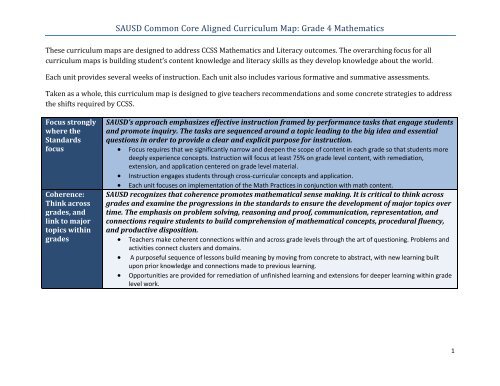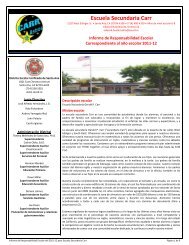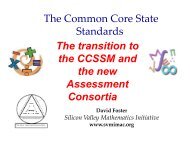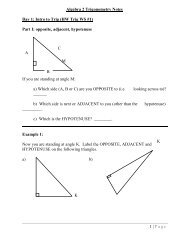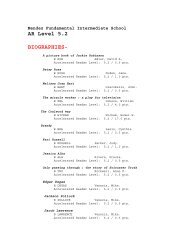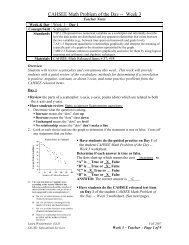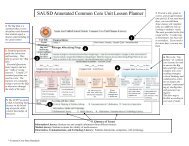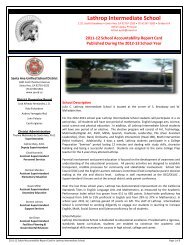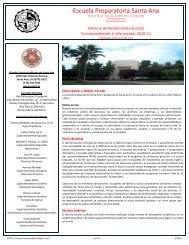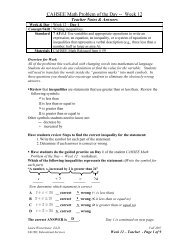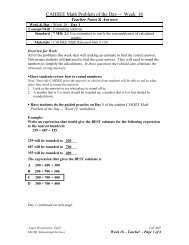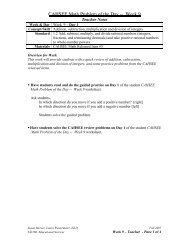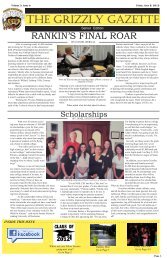2013-2014 Curriculum Map Grade 4 Math
2013-2014 Curriculum Map Grade 4 Math
2013-2014 Curriculum Map Grade 4 Math
You also want an ePaper? Increase the reach of your titles
YUMPU automatically turns print PDFs into web optimized ePapers that Google loves.
SAUSD Common Core Aligned <strong>Curriculum</strong> <strong>Map</strong>: <strong>Grade</strong> 4 <strong>Math</strong>ematicsThese curriculum maps are designed to address CCSS <strong>Math</strong>ematics and Literacy outcomes. The overarching focus for allcurriculum maps is building student’s content knowledge and literacy skills as they develop knowledge about the world.Each unit provides several weeks of instruction. Each unit also includes various formative and summative assessments.Taken as a whole, this curriculum map is designed to give teachers recommendations and some concrete strategies to addressthe shifts required by CCSS.Focus stronglywhere theStandardsfocusCoherence:Think acrossgrades, andlink to majortopics withingradesSAUSD’s approach emphasizes effective instruction framed by performance tasks that engage studentsand promote inquiry. The tasks are sequenced around a topic leading to the big idea and essentialquestions in order to provide a clear and explicit purpose for instruction. Focus requires that we significantly narrow and deepen the scope of content in each grade so that students moredeeply experience concepts. Instruction will focus at least 75% on grade level content, with remediation,extension, and application centered on grade level material. Instruction engages students through cross-curricular concepts and application. Each unit focuses on implementation of the <strong>Math</strong> Practices in conjunction with math content.SAUSD recognizes that coherence promotes mathematical sense making. It is critical to think acrossgrades and examine the progressions in the standards to ensure the development of major topics overtime. The emphasis on problem solving, reasoning and proof, communication, representation, andconnections require students to build comprehension of mathematical concepts, procedural fluency,and productive disposition. Teachers make coherent connections within and across grade levels through the art of questioning. Problems andactivities connect clusters and domains. A purposeful sequence of lessons build meaning by moving from concrete to abstract, with new learning builtupon prior knowledge and connections made to previous learning. Opportunities are provided for remediation of unfinished learning and extensions for deeper learning within gradelevel work.1
SAUSD Common Core Aligned <strong>Curriculum</strong> <strong>Map</strong>: <strong>Grade</strong> 4 <strong>Math</strong>ematicsRigor: In majortopics, pursueconceptualunderstanding,proceduralskills andfluency, andapplicationSAUSD’s approach emphasizes increased rigor: Conceptual understanding, procedural skills &fluency, and real-world applications will be taught with equal intensity. These elements may beexplicitly addressed separately or at other times combined. Students demonstrate deep conceptualunderstanding of core math concepts by applying them in new situations, as well as writing andspeaking about their understanding. Students will make meaning of content outside of math byapplying math concepts to real-world situations. Conceptual understanding underpins fluency; fluency is practiced in contextual applications; and applicationsbuild conceptual understanding. Each unit contains a balance of challenging, multiple-step problems to teach new mathematics, and exercises topractice mathematical skills.The Standards for <strong>Math</strong>ematical Practice describe varieties of expertise that mathematics educators at all levels should seek to developin their students. These practices rest on important “processes and proficiencies” with longstanding importance in mathematicseducation. The first of these are the NCTM process standards of problem solving, reasoning and proof, communication, representation,and connections. The second are the strands of mathematical proficiency specified in the National Research Council’s report Adding It Up:adaptive reasoning, strategic competence, conceptual understanding (comprehension of mathematical concepts, operations andrelations), procedural fluency (skill in carrying out procedures flexibly, accurately, efficiently and appropriately), and productivedisposition (habitual inclination to see mathematics as sensible, useful, and worthwhile, coupled with a belief in diligence and one’s ownefficacy).The Standards for <strong>Math</strong>ematical Practice are interwoven into every Unit of Study. Individual lessons may focus on oneor more of the <strong>Math</strong> Practices, but every unit must include all eight:1. Make sense of problems and persevere in solving them.2. Reason abstractly and quantitatively.3. Construct viable arguments and critique the reasoning of others.4. Model with mathematics.5. Use appropriate tools strategically.6. Attend to precision in computation, vocabulary and argument.7. Look for and make use of structure.8. Look for and express regularity in repeated reasoning.2
SAUSD Common Core Aligned <strong>Curriculum</strong> <strong>Map</strong>: <strong>Grade</strong> 4 <strong>Math</strong>ematicsHow to Read this DocumentThe purpose of this document is to provide an overview of the progression of units of study within a particular gradelevel describing what students will achieve by the end of the year. The work of Big Ideas and Essential Questions isto provide an overarching understanding of the mathematics structure that builds a foundation to support the rigor ofsubsequent grade levels. The standards listed include not only the <strong>Math</strong>ematics Content Standards, but also theLiteracy and ELD Standards by which the students express their learning. The Final Performance Task will assessstudent learning via modeling of complex mathematical situations. Each unit incorporates components of the SAUSDTheoretical Framework and the philosophy of Quality Teaching for English Learners (QTEL). Each of the mathunits of study highlights the Common Core instructional shifts for mathematics of focus, coherence, and rigor.First, read each module overview paragraph. This describes the purpose for the unit and the connections with previousand subsequent units. The content standards that are central to each unit are also listed here.On the map, note the titles across the year: These show the progression of units drawn from various domains.The timeline tells the length of each unit and when each unit should begin and end.FOURTH GRADE UNITS OF STUDYUnit 1Unit 2Unit 3Structure of Whole NumbersIn this unit, students will study the place value system to understand the relationship between numbers. They will know the relativesizes of various units of measure. For this year only, the study of negative numbers will be included.This unit centers on <strong>Math</strong> Content Standards 4.AO.5, 4.NBT.1, 4.NBT.2, 4.NBT.3Addition and Subtraction of Whole NumbersStudents will fluently add and subtract numbers with multiple digits. They will solve problems involving measurement of distance,time, volume, mass, and money. They will apply the perimeter formula for rectangles.This unit centers on <strong>Math</strong> Content Standards 4.NBT.4, 4.MD.2, 4.MD.3Whole Number MultiplicationThis unit relates repeated addition to the process of multiplication. Students will make visual representations of multiplicationsituations. They will use variables in algebraic expressions. They will find all the factor pairs for given numbers. They will apply thearea formula to rectangles. They will make unit conversions within one system of measurement.This unit centers on <strong>Math</strong> Content Standards 4.AO.1, 4.AO.2, 4.AO.3, 4.AO.4, 4.AO.5, 4.NBT.5, 4.MD.1, 4.MD.2, 4.MD.33
SAUSD Common Core Aligned <strong>Curriculum</strong> <strong>Map</strong>: <strong>Grade</strong> 4 <strong>Math</strong>ematicsor perpendicular lines, identify angles as acute, right, or obtuse, based upon the portion of a circle shown, create a foldable todisplay geometric terms, conduct a close read with a video clip about polygons, and create plane geometric figures with hands-onmaterials. The final performance task will be to create a map utilizing all the geometric components explored throughout the unit.Scaffolded support is provided for English Language Learners and Students with Disabilities. Support is provided for collaborativeconversations, using <strong>Math</strong> Talk, including sample sentence frames. Classroom connections to the ST <strong>Math</strong> Program are referencedthrough the teacher mode.This unit centers on <strong>Math</strong> Content Standards 4.G.1, 4.G.2, and 4.G.3, 4.MD55
SAUSD Common Core Aligned <strong>Curriculum</strong> <strong>Map</strong>: <strong>Grade</strong> 4 <strong>Math</strong>ematicsTIMELINE4 Weeks4 Weeks4 WeeksLate August to Late September Late September to Late October Late October to Late NovemberTRIMESTER 1 UNIT 1 UNIT 2 UNIT 3TITLEEND OF UNITPERFORMANCETASKStructure of Whole NumbersCreate a flipbook to illustrate the base tensystem of numbers.Big Idea 1 : Quantities can be purposefullyrepresented and compared in many ways.Addition and Subtraction ofWhole NumbersWrite and solve a word problem to depicta given addition or subtraction problem.Big Idea: Quantities can be combined andseparated in many ways.Whole Number MultiplicationCalculate the area of the classroom.Big Idea: Quantities can be grouped intomany different amounts.BIG IDEAS ANDESSENTIALQUESTIONCOMPLEX TEXTS /RESOURCES• How does our place value system work?• Why is the number to the left ten timesgreater than the number to the right?Big Idea 2 : Attributes of objects can bequantified using unit amounts.• How do various units help us understandmeasurement?• What is the purpose of the algorithm youuse for adding?• What is the purpose of the algorithm youuse for subtracting?• How do measurement units help us tounderstand what is being measured?• What does perimeter help you understand?HM Chapters 1, 2, 16 HM Chapters 3, 4, 5, 15.2, 15.6, 27.2• How does repeated addition relate tomultiplication?• Why do you place a zero when multiplyingmultiple digits?• What does the area formula help you find?• Why do you use multiplication to find area?• How do factors relate to multiplication?HM Chapters 7, 8, 9, 10, 11, 15.3, 15.4,15.5, 27MATH CONTENTSTANDARDSCENTRAL TO THISUNIT4.AO.5 Generate a number or shape pattern thatfollows a given rule. Identify apparent features ofthe pattern that were not explicit in the rule itself.4.NBT.1 Recognize that in a multi-digit wholenumber, a digit in one place represents ten timeswhat it represents in the place to its right.4.NBT.2 Read, write & compare multi-digitnumbers using base-ten numerals, number names,and expanded form.4.NBT.3 Use place value understanding to roundmulti-digit whole numbers to any place.4.NBT.4 Fluently add and subtract multi-digitwhole numbers using the standard algorithm.4.MD.2 Solve word problems involving distances,intervals of time, liquid volumes, masses of objects,and money. Represent measurement quantitiesusing diagrams.4.MD.3 Apply the perimeter formula forrectangles.4.AO.1 Interpret a multiplication equation as acomparison.4.AO.2 Multiply to solve word problems involvingmultiplicative comparison.4.AO.3 Solve multistep word problems posed withwhole numbers and having whole-number answer.Represent these problems using equations with aletter standing for the unknown quantity.4.AO.4 Find all factor pairs for a whole number inthe range 1-100.4.AO.5 Generate a number or shape pattern thatfollows a given rule. Identify apparent features of6
SAUSD Common Core Aligned <strong>Curriculum</strong> <strong>Map</strong>: <strong>Grade</strong> 4 <strong>Math</strong>ematicsSTANDARDS OFMATHEMATICALPRACTICECENTRAL TO THISUNITREADINGINFORMATIONALSTANDARDSCENTRAL TO THISUNITWRITINGSTANDARDSMP2 Students recognize that a number represents aspecific quantity. They connect the quantity towritten symbols and create a logical representationof the problem at hand, considering both theappropriate units involved and the meaning ofquantities.MP7 Students look closely to discover a pattern orstructure. They generate number or shape patternsthat follow a given rule.MP1 Students may use concrete objects or picturesto help them conceptualize and solve problems.MP3 Students not only explain their own thinking,but listen to others’ explanations.MP4 Students experiment with representingproblem situations in multiple ways includingnumbers, words, drawing pictures, using objects,making a chart, list or graph, and creatingequations.MP5 Students use measurement tools tounderstand the relative size of units within a systemand express measurements given in larger units interms of smaller units.MP6 Students are careful about specifying the unitsof measure and state the meaning of the symbolsthey choose.MP8 Students notice repetitive actions incomputation to make generalizations.the pattern that were not explicit in the rule itself.4.NBT.5 Multiply a whole number of up to fourdigits by a one-digit whole number, and multiplytwo two-digit numbers. Illustrate and explain thecalculation.4.MD.1 Know relative sizes of measurement unitswithin one system of units. Record measurementequivalents in a two-column table.4.MD.2 Solve word problems involving distances,intervals of time, liquid volumes, masses of objects,and money and expressing measurements given in alarger unit in terms of a smaller unit.4.MD.3 Apply the area formula for rectangles.MP1 Students know that doing mathematicsinvolves solving problems and discussing how theysolved them.MP3 Students may construct arguments usingconcrete referents, such as objects, pictures,drawings, and actions.MP4 Students need opportunities to connectdifferent representations and explain theconnections.MP6 Students try to use clear and precise languagein their discussions with others and in their ownreasoning.MP7 Students use properties of operations toexplain calculations (partial products model). Theyrelate representations of counting problems such astree diagrams and arrays to the multiplicationprincipal of counting.MP8 Students use models to explain calculationsand understand how algorithms work.3. Use knowledge of language and its conventions when writing, speaking, reading, or listening.c. Differentiate between contexts that call for formal English (e.g., presenting ideas) and situations where informal discourse is appropriate (e.g., small-groupdiscussion).6. Acquire and use accurately grade-appropriate general academic and domain-specific words and phrases.7
SAUSD Common Core Aligned <strong>Curriculum</strong> <strong>Map</strong>: <strong>Grade</strong> 4 <strong>Math</strong>ematicsLISTENING ANDSPEAKINGSTANDARDS1. Engage effectively in a range of collaborative discussions (one-on-one, in groups, and teacher-led) with diverse partners on grade 4 topics and texts, building onothers’ ideas and expressing their own clearly.a. Come to discussions prepared having read or studied required material; explicitly draw on that preparation and other information known about the topic toexplore ideas under discussion.b. Follow agreed-upon rules for discussions and carry out assigned roles.c. Pose and respond to specific questions to clarify or follow up on information, and make comments that contribute to the discussion and link to the remarks ofothers.d. Review the key ideas expressed and explain their own ideas and understanding in light of the discussion.4. Report on a topic or text, tell a story, or recount an experience in an organized manner, using appropriate facts and relevant, descriptive details to support mainideas or themes; speak clearly at an understandable pace.ELD STANDARDSCROSS-CONTENT/REAL WORLDCONNECTIONSCompare populations of cities in CaliforniaMetric measurementMultiple units of measurementArea of rectangles in real life8
SAUSD Common Core Aligned <strong>Curriculum</strong> <strong>Map</strong>: <strong>Grade</strong> 4 <strong>Math</strong>ematicsTTIMELINE4 weeksDecember to Late January4 WeeksLate January to Late February4 WeeksMarchTRIMESTER 2 UNIT 4 UNIT 5 UNIT 6TITLEWhole Number Division Fraction Equivalence Operations with FractionsEND OF UNITPERFORMANCETASKBIG IDEAS ANDESSENTIALQUESTIONWrite a story problem for a givenexpression. Solve the problem, explainingthe steps in the process.Big Idea: Quantities can be divided intoequal groups.• How is repeated subtraction related toequal groups in division? What are thepatterns that occur?• How can you prove the properties ofmultiplication and the rules of division?• What is another way to solve a divisionproblem using a different algorithm?• How is a remainder expressed?• Where have you used division to solve aproblem in your life?Create a floor plan of a house with givenfractional parts for each room.Big Idea: Relationships between portionscan be represented in many ways.• How can you represent fractions using anarea model?• How can you represent fractions using anumber line?• What are some equivalent representationsfor fractions and mixed numbers?• How can you represent/compare fractionsthat are related to different wholes?Compute the distance traveled whengiven fractional numbers.Big Idea: Portions can be combined orseparated in many ways.• What are some ways that fractions can becombined or separated?• How can addition and subtraction offractions be applied to real life situations?• How does the size of the factors affect thesize of the product?• How can the multiplication of fractions beapplied to real life situations?COMPLEX TEXTS /RESOURCES HM Chapters 6, 12, 13, 14 HM Chapters 17.1–17.4, 18 HM Chapter 15.1, 17.5, 17.6MATH CONTENTSTANDARDSCENTRAL TO THISUNIT4.AO.2 Divide to solve word problems involvingmultiplicative comparison.4.AO.3 Solve multistep word problems posed withwhole numbers and having whole-number answer.Represent these problems using equations with aletter standing for the unknown quantity.4.AO.4 Find all factor pairs for a whole number inthe range 1-100.4.NBT.6 Find whole-number quotients andremainders with up to four-digit dividends and onedigitdivisors. Illustrate and explain the calculation.4.MD.2 Solve word problems involving distances,intervals of time, liquid volumes, masses of objects,4.NF.1 Explain why a fraction a/b is equivalent tofraction (axb)/(nxb) by using visual fraction models.4.NF.2 Compare two fractions with differentnumerators and different denominators.4.NF.5 Express a fraction with denominator 10 asan equivalent fraction with denominator 100, anduse this technique to add two fractions withrespective denominators 10 and 100.4.NF.3 Understand a fractional/b with a>1 as asum of fraction 1/b.4.NF.3a Understand addition and subtraction offractions.4.NF.3 Understand a fractional/b with a>1 as asum of fraction 1/b.4.NF.3a Understand addition and subtraction offractions.4.NF.3b Decompose a fraction as a sum offractions with the same denominator in more thanone way.4.NF.3c Add and subtract mixed numbers with likedenominators.4.NF.3d Solve word problems involving additionand subtraction of fractions.4.NF.4 Apply and extend previous understandings9
SAUSD Common Core Aligned <strong>Curriculum</strong> <strong>Map</strong>: <strong>Grade</strong> 4 <strong>Math</strong>ematicsSTANDARDS OFMATHEMATICALPRACTICECENTRAL TO THISUNITREADINGINFORMATIONALSTANDARDSCENTRAL TO THISUNITWRITINGSTANDARDSand money and expressing measurements given in alarger unit in terms of a smaller unit.4.MD.3 Apply the area formula for rectangles.MP1 Students explain to themselves the meaning ofa problem and look for ways to solve it.MP3 Students decide if explanations make senseand ask appropriate questions.MP4 Students experiment with representingproblem situations in multiple ways and should beable to use all of these representations as needed.MP8 Students examine patterns and generate theirown algorithms.4.NF.3b Decompose a fraction as a sum offractions with the same denominator in more thanone way.4.MD.4 Make a line plot to display a data set ofmeasurement in fractions of a unit (1/2, 1/4, 1/8).MP2 Students recognize that a number represents aspecific quantity. They connect the quantity towritten symbols and create a logical representationof the problem at hand, considering both theappropriate units involved and the meaning ofquantities. They extend this understanding fromwhole numbers to their work with fractions anddecimals.MP5 Students may use graph paper or a numberline to represent and compare decimals.MP6 Students use appropriate labels when creatinga line plot.MP8 Students use visual fraction models to writeequivalent fractions.of multiplication to multiply a fraction by a wholenumber.4.NF.4a Understand a fraction a/b as a multiple of1/b.4.NF.4b Understand a multiple of a/b as amultiple of 1/b.4.NF.4c Solve word problems involvingmultiplication of a fraction by a whole number.4.NF.5 Express a fraction with denominator 10 asan equivalent fraction with denominator 100, anduse this technique to add two fractions withrespective denominators 10 and 100.4.MD.2 Solve word problems involving distances,intervals of time, liquid volumes, masses of objects,and money.4.MD.4 Make a line plot to display a data set ofmeasurement in fractions of a unit (1/2, 1/4, 1/8).Solve problems involving addition and subtractionof fractions.MP1 Students listen to the strategies of others andwill try different approaches.MP3 Students not only explain their own thinking,but listen to others’ explanations.MP4 Students need opportunities to connectdifferent representations and explain theconnections.MP5 Students consider the available tools (includingestimation) when solving a mathematical problemand decide when certain tools might be helpful.MP8 Students use models to explain calculationsand understand how algorithms work.3. Use knowledge of language and its conventions when writing, speaking, reading, or listening.c. Differentiate between contexts that call for formal English (e.g., presenting ideas) and situations where informal discourse is appropriate (e.g., small-groupdiscussion).6. Acquire and use accurately grade-appropriate general academic and domain-specific words and phrases.10
SAUSD Common Core Aligned <strong>Curriculum</strong> <strong>Map</strong>: <strong>Grade</strong> 4 <strong>Math</strong>ematicsLISTENING ANDSPEAKINGSTANDARDSELD STANDARDS1. Engage effectively in a range of collaborative discussions (one-on-one, in groups, and teacher-led) with diverse partners on grade 4 topics and texts, building onothers’ ideas and expressing their own clearly.a. Come to discussions prepared having read or studied required material; explicitly draw on that preparation and other information known about the topic toexplore ideas under discussion.b. Follow agreed-upon rules for discussions and carry out assigned roles.c. Pose and respond to specific questions to clarify or follow up on information, and make comments that contribute to the discussion and link to the remarks ofothers.d. Review the key ideas expressed and explain their own ideas and understanding in light of the discussion.4. Report on a topic or text, tell a story, or recount an experience in an organized manner, using appropriate facts and relevant, descriptive details to support mainideas or themes; speak clearly at an understandable pace.CROSS-CONTENT/REAL WORLDCONNECTIONSPose problems about transporting students on fieldtripsOrdering boxes of pencils for schoolsMeasuring heightOCR theme of money: students write wordproblems involving division of moneyScience unit of Rocks and Minerals: students makearrays of rocks in a rock collectionCompute distance traveled on a car trip or hike11
SAUSD Common Core Aligned <strong>Curriculum</strong> <strong>Map</strong>: <strong>Grade</strong> 4 <strong>Math</strong>ematicsTIMELINE3 Weeks4 Weeks3 WeeksAprilMayJuneTRIMESTER 3 Unit 7 UNIT 8 UNIT 9TITLEEND OF UNITPERFORMANCETASKBIG IDEAS ANDESSENTIALQUESTIONDecimalsCalculate the volume of a tank of water,by measuring in centimeters andconverting to liters.Big Idea: Portions can be combined orseparated in many ways.• How are fractions and decimals related?• How does the base ten number system helpus to understand decimals?• How are decimals used in the metricmeasurement system?• What are some ways that decimals can becombined or separated?• How can addition and subtraction ofdecimals be applied to real life situations?MeasurementMake a scale-model drawing ofsomething, using centimeters to representmeters or inches to represent miles.Big Ideas: Objects can be described,classified, measured, and analyzed basedon their attributes.• What are the units of measurement wecommonly use?• How are units of measurement related?• How does measurement help us understandreal life situations?• What does angle measurement mean?• How are angles found in real life situations?• How can you use only a right angle to classifyall angles?Lines, Angles, and2-Dimensional ShapesDesign a map, which includes varioustypes of lines and geometric shapes.Big Idea: Objects can be described,classified, and analyzed based on theirattributes.• What geometric components make upfigures (point, line, line segment, angles, rays)?• How can parallel and perpendicular lines beidentified?• How can you use only a right angle to classifyall angles?• How do angles and lines help us to classifyshapes?• What properties do geometric objects havein common?• How can we find a line of symmetry incertain geometric shapes?COMPLEX TEXTS /RESOURCES HM Chapters 19, 20 HM Chapter 15 HM Chapters 25, 26, 28MATH CONTENTSTANDARDSCENTRAL TO THISUNIT4.NF.5 Express a fraction with denominator 10 asan equivalent fraction with denominator 100, anduse this technique to add two fractions withrespective denominators 10 and 100.4.NF.6 Use decimal notation for fractions withdenominators 10 or 100.4.NF.7 Compare two decimals to hundredths byreasoning about their size. Record the results of4.MD.1 Know relative sizes of measurement unitswithin one system of units.4.MD.2 Solve word problems involving distances,intervals of time, liquid volumes, masses of objects,and money and expressing measurements given in alarger unit in terms of a smaller unit.4.MD.5 Recognize angles as geometric shapes thatare formed whenever two rays share a common4.MD.5 Recognize angles as geometric shapes thatare formed whenever two rays share a commonendpoint.4.G.1 Draw & identify points, lines, line segments,rays, angles (right, acute, obtuse), andperpendicular and parallel lines.4.G.2 Classify 2-D figures based on parallel orperpendicular lines, or angles of a specified size.12
SAUSD Common Core Aligned <strong>Curriculum</strong> <strong>Map</strong>: <strong>Grade</strong> 4 <strong>Math</strong>ematicscomparisons with the symbols >, =, or
SAUSD Common Core Aligned <strong>Curriculum</strong> <strong>Map</strong>: <strong>Grade</strong> 4 <strong>Math</strong>ematicsELD STANDARDSCROSS-CONTENT/REAL WORLDCONNECTIONSCompare measurements within a given system(metric or common)Parallel and perpendicular lines in the world aroundus (streets, buildings, signs)<strong>Map</strong> skillsRevised 11/08/1314


